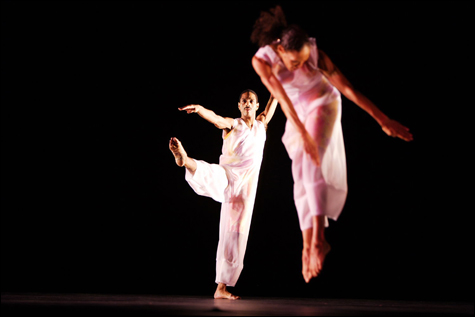
‘A TRUE JAZZ FEELING’: Two of Fagan’s dancers.
|
When Garth Fagan came to the States from his native Jamaica in 1960, he brought the Afro-Caribbean dance he’d grown up with, and in 1970, he formed a company called the Bottom of the Bucket . . . but Dance Theatre, referring to the inner-city youth and student athletes he was working with. Twenty years later, with a solid international reputation, they became Garth Fagan Dance, and in 1998, Fagan won a Tony Award for his choreography for The Lion King. Fagan’s Rochester, New York-based company makes its first appearance in Providence at Rhode Island College on February 20 at 8 pm (call 401.456.8144).
In the years since Fagan formed his modern dance company, many ballets have taken on a “modern” look, bare feet and all. But the roots of modern dance are firmly planted in the soil of early African-American choreographers who introduced elements of African and Caribbean movement to American modern dance.
Fagan wanted his company to be truly modern-based, with the rhythms and postures of African and Caribbean dance blended with the precision of ballet. He developed ways to teach what he envisioned— it’s now known as the Fagan Technique and is taught at a school connected to the company.
“I wanted the bravura and the risk-taking of athletes as opposed to the precious-dancer theme of the ’70s,” Fagan recalled, in a phone conversation from a hotel room in St. Paul, Minnesota. “I just wanted them to feel the concept of people dancing as opposed to dancers as trained people. I wanted my women to be as strong as the men: to do leaps and hang in the air and to turn as fast as the men. And I wanted my men to be as vulnerable as the women.”
To underscore the pure look that Fagan was going for, he eliminated preparatory steps for jumps or turns. The dancers seem to just rise off the floor or glide into a turn, which gives a sense of surprise and freshness to Fagan’s pieces. The dancers may also be doing a rigorous turn with their feet and legs while their arms, torsos, and heads are going in different directions or at different speeds.
“I feel that as a contemporary choreographer, I have a right to push the art form forward,” Fagan affirmed. “Movement invention is my favorite thing. I come up with lifts you haven’t seen anywhere else.”
Fagan favors a wide span of music, including jazz, classical, and hip-hop. He stressed that his dancers have to be great musicians to perform his pieces, because he doesn’t use typical phrasing, with a step falling right on a beat.
“It’s more a true jazz feeling,” he reflected, “the same way that in a fine jazz band, all the soloists listen to the one who played before and then comment on it and then add something to it. So with the dancers, you have a true conversation and a true illumination of space and time.”
Fagan begins each program in a new venue with an early piece titled Prelude, set to music by Abdullah Ibrahim and Max Roach. In it, each of the 12 dancers demonstrates Fagan-style steps and poses.
“Some people will love ’em, some people will hate ’em, some people won’t be sure — that’s how you should perceive art,” Fagan noted.
Next is an excerpt from DanceCollageForRomie, a duet based on a collage by Romare Bearden, set to Villa-Lobos’s “Bachianas Brasileiras No. 5.” It’s followed by the satiric Touring Jubilee 1924, set to the Preservation Hall Jazz Band and termed by Fagan “a spin on a company that’s very full of itself.”
Two longer pieces, Senku and Translation/Transition, draw on African and Jamaican sources, respectively, and each have multiple movements. Senku features two stunning solos from male dancers, plus a duet and a full-company section. Translation/Transition is built on music performed by a British group, the Jazz Jamaica All-Stars, who twine jazz standards and Jamaican rhythms together.
“I like audiences to take with them the physicality of dance, but I also like the dances to have intellectual and cultural depth, so that the mind is plugged into thinking, ‘What could this really mean?’ or ‘Oh, yeah, I’ve experienced this,’ so that there’s not an emptiness to the work.”
Fagan certainly needn’t worry about that.